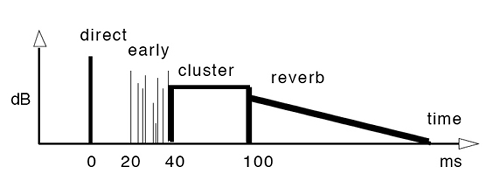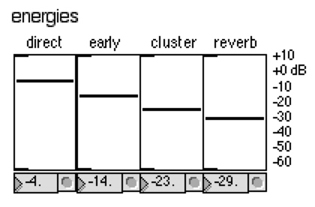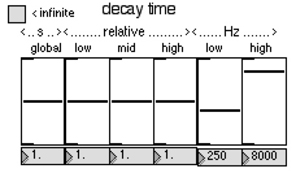Spatialisateur
Spat Introduction
|
The Room~ ModuleIntroductionRoom~ is an artificial reverberator allowing room effect synthesis and control in real time, based on digital signal processing algorithms under license from France Télécom [4]. Room~ can be made in several versions having different complexities. This allows the user, according to the application, to make the best use of the available processing resources. Room~ receives two signals and outputs seven signals. The two input signals are the direct signal and the room signal. If a Source~ module is connected to the inputs of Room~, the direct and room signal inlets should respectively receive the face and omni outputs from the Source~ module (see previous section). The seven ouput signals are divided into three groups:
This format allows to control the directional aspects of the artificial room effect irrespective of the reproduction setup (see description of the Pan~ module below). This output format is directly compatible with the 3/2-Stereo format, derived from the video and motion-picture industry, comprising three front channels and two surround channels [5a]. Assuming a frontal direct sound, the ouputs of the Room~ module can be directly reproduced on a 3/2-Stereo (or even 3/4-Stereo) loudspeaker setup, with no additionnal processing. The 3/2-Stereo format is downward compatible with loudspeaker setups comprising a lower number of channels, including conventional (2/0) stereo or 4-channel systems (2/2- or 3/1-Stereo) [5b]. The output signals of Room~ can be readily downmixed for reproduction on these loudspeaker setups. The role of the Pan~ module is to provide dynamic matrixing of these output signals, allowing non-frontal localization of the sound source or sound event. The functional description below follows the division of the graphical control interface Room~ into three main parts: time structure, equalization, and decay time. Time StructureThe response of the full version of Room~ is divided into four time sections:
 Time Structure of Generic Room Effect The energies (in dB) and time limits (in ms) of these four sections can be controlled independently, which can be exploited to imitate the acoustics of rooms of various sizes. Modifying the limits of the early section sets default values for the dates of the early reflections, which can then be tuned individually. The three sections of the room effect can overlap, but the algorithm imposes some constraints (the lower limits must follow the chronological order given above, and the cluster section cannot be shorter than the early section). This is a conventional way of describing the room effect [2, 4], except for the separation of the early room effect into two sections, resulting in the intermediate packet of reflections "cluster". The default time limits are roughly set to 20-40 ms for early reflections, 40-100 ms for later reflections, 100 ms and beyond for late reverberation. This generic room effect model is derived from studies of the perceptual characterization of the room acoustic quality of concert halls [6].  The Energies Control Interface These psychoacoustic studies led to the conception of a user interface where each control is more directly related to the listeners's perception than the energies of the different time sections (which is what is proposed in the "low-level" control interface reproduced in the figure above). In section 4 of this document, a "high-level" user interface is described which includes a perceptual control panel for describing the artificial room effect. Nota Bene: The complexity (and, consequently, the processing cost) of the artificial reverberation algorithm can be reduced by simplifying the time structure described above, at the expense of reduced flexibility in controlling the synthesized room effect. The most natural simplification consists in dropping the intermediate cluster section, in which case the reverberation starts decaying exponentially right after the early reflections. Further simplification is obtained by dropping the early section, for applications where controlling the early reflections is not of interest. Of course, dropping the reverb section to keep only the early and cluster sections is possible too, as well as keeping only the early section. Spectral CorrectionsSpectral correction can be applied individually on each of the four time sections defined above, by use of the four equalizers provided in Room_: direct, room, early, cluster. These four equalizers are of the "double shelving" type described earlier. The main filters are the direct and room filters, which, as described in earlier, can be used to account approximately for the radiation characteristics of the sound source. Typically, for a sound source directed towards the listener, the room equalization should be set to cut higher frequencies compared to the direct equalization, since most natural sources are more directive at higher frequencies, and tend to become omnidirectional at low frequencies. The two additional equalizers, early and cluster, can be used if necessary to fine-tune the spectral content of the early room effect, relative to the global room equalization. No additional filter is necessary for the reverb section, whose spectral content is simply determined by the room filter. Decay TimeThe decay time control sets the exponential decay rate of the late reverberation (reverb section) as a function of frequency. The decay time is measured in seconds and defined as the time it takes for the late reverberation to drop 60 dB below its initial level, after an interruption of the input signal. The decay time is controlled in the same way as an equalizer curve, either globally or in three separate frequency bands with controllable transition frequencies, and can be varied from 0.1 s to 100 s. A toggle switch allows to momentarily set the decay time to infinite, then back to its initial setting.  The Decay Control Interface |
© CNAC-GP/Ircam and Espaces Nouveaux |